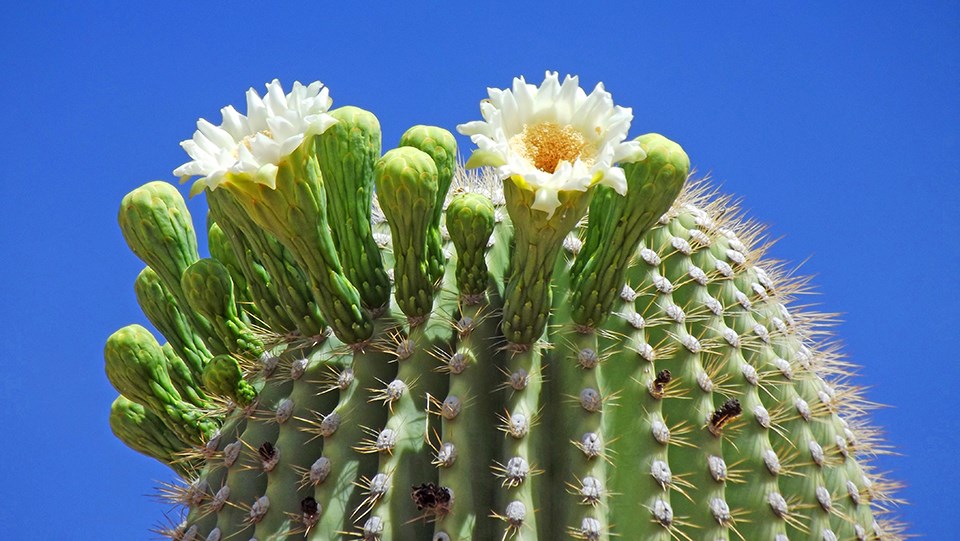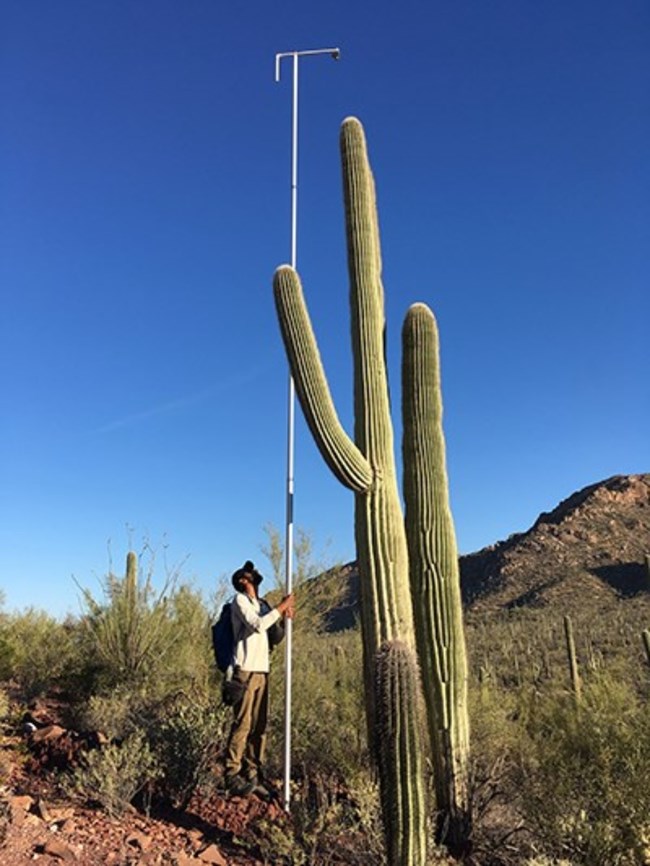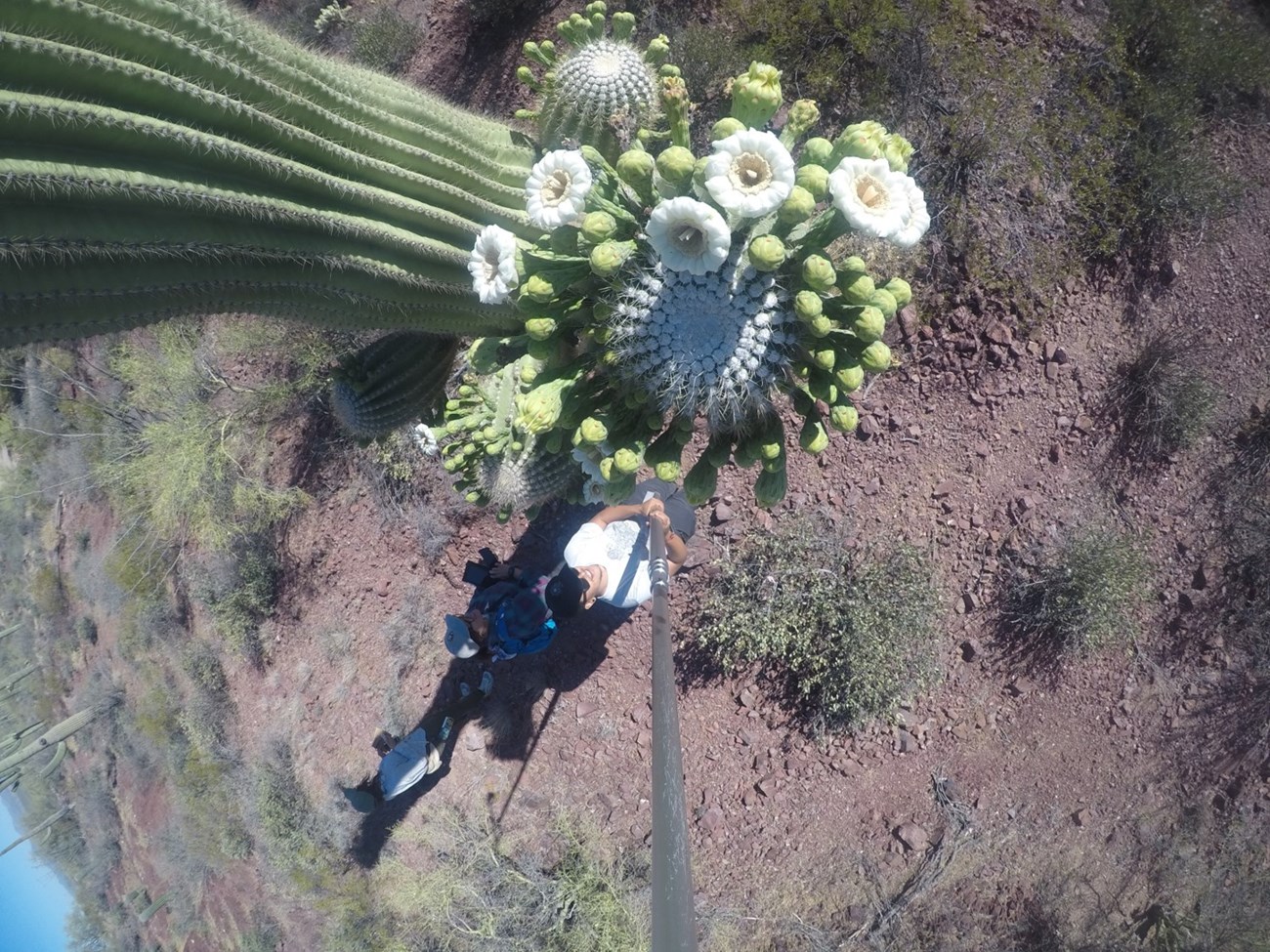
T. Foley 
IntroductionEach spring the giant saguaro cactus produces one of the most beautiful flowers of the Sonoran Desert. The large white flowers with yellow centers bloom at night and close the following day. They are pollinated by birds, insects, and even bats. Saguaro National Park is within the traditional lands of the Tohono O’odham People, who continue a long traditional relationship with the saguaro through an annual fruit harvest in the park. Temperatures at Saguaro have increased about 2° F in the past century, and many people wonder if this warming may lead to saguaro flowers blooming earlier than they did in the past, which could cause them to become out of sync with the seasons of their pollinators. From 2017-2023, Saguaro National Park studied saguaro flowering phenology to address these questions. Each day from early April through July interns and volunteers photographed the buds, flowers, and fruit of more than 50 saguaros and their arms using a digital camera mounted on top of a 30 foot long "selfie stick". Our goal was to tie the flowering dates with meteorological measurements and past data to learn more about changes over time. We are proud of our volunteers and interns from the Latin Heritage Internship Program and Next Gen rangers supported by the Friends of Saguaro National Park and Western National Parks Association. 
NPS/Lupe S. 
What is phenology?Phenology is the study of periodic plant and animal life cycle events, such bird migration in the spring, or when saguaro cacti bloom and produce fruit. Saguaros reach reproductive age and put forth their first flowers when they reach a height of about 2.2 meters (7 feet), or when they are 30-65 years old. Saguaro flowering begins around the last two weeks of April, and peak flowering occurs during the last week of May through the first week in June. Saguaro flowering is triggered when the days grow longer and temperatures rise. The fruit typically ripens into a deep red color in late June and early July. They drop thousands of tiny seeds in anticipation of the summer rains during July and August. 
NPS What have we learned so far, how many flowers?Our thousands of photos of buds, flowers, and fruit reveal fascinating changes throughout the seven years. Saguaros produce more flowers some years than others – for example, we had a total of only 1,705 flowers in 2022, but more than 9,400 in 2023! 

NPS Flowering in a counter-clockwise directionWe also observed that the buds and flowers are not evenly distributed over the top (or crown) of the saguaro. The buds and flowers typically appear first on the eastern side of saguaro crowns, then spread to the north, then west – that is, they appear in sequence in a counter-clockwise direction. We do not know of any other plant in the world that does this! Why saguaros flower this way is not understood but may have to do with early buds taking advantage of the morning sun on the east side. Buds later in the season may be located to avoid the sun as the desert temperatures climb. The order in which they appearAnother interesting observation from the study is that saguaros in an area tend to always flower in sequence to each other – that is, a saguaro that blooms early one year will bloom early the next year, and one that blooms late will bloom late the next year. We can practically predict the order in which the saguaros in our study area will bloom every single year – something that has been seen in European oak trees and other long-lived plants. But they don’t start and stop on the same date every year! Rather, the sequences are offset from year by several days or more. We are still analyzing the data, but there seem to be environmental triggers (such as cooler and warmer temperatures) that cause these differences. Become a Citizen ScientistVolunteers collect the photo data from April 1 until mid-July in the western district of Saguaro National Park (in the Tucson Mountains, a few miles north of the Arizona Sonora Desert Museum). Although some citizen scientists return each year, we may have openings during the 2021 field season for volunteers who can commit to most or all of the season. We typically start early in morning and work for 1-2 hours. It is a hot time of year and the terrain is very rugged, so you must be heat-tolerant and sure-footed! If you are interested in participating, please email Don Swann at Don_Swann@nps.gov. |
Last updated: May 6, 2025
